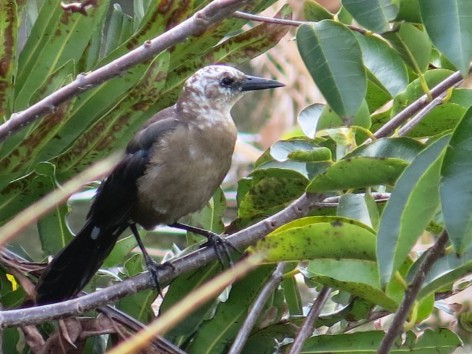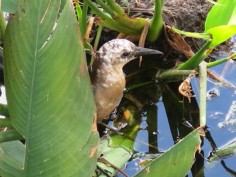William E. Davis, Jr.

Fig. 1. Leucistic Boat-tailed Grackle. (All photographs by the author.)
On March 3, 2015, at about 3:00 pm, at the Wakodahatchee Wetlands near Delray Beach, Florida, I observed a female Boat-tailed Grackle (Quiscalis major), which had plumage abnormalities. Instead of the normal cinnamon brown above and buffy brown below, this bird had a largely white head, white undertail coverts, and scattered white feathers on its breast and upper back (Figures 1, 2). The distribution of white feathers on the head and breast were asymmetrical (Figure 1). I did not see the back and upper tail well as the bird was flitting about in dense foliage. A local birder told me that he had seen the bird in the same area for several years so the bird was an adult.
Although many would call this bird a ‘partial albino,’ the correct term is ‘leucino’ because albinism is defined as the total absence of all pigmentation, resulting in all white feathers; pink eyes (there is no melanin to obscure blood circulation); and light colored bills, legs, and feet (Buckley 1982). Leucism is the complete loss of a particular pigment or pigments in feathers but not in soft parts. It may be complete or partial, in an extreme case affecting only a single feather, and it can be symmetrical or asymmetrical. Because the shades of browns and black coloration of this bird are probably produced by one or more melanins, the proper designation for this bird is non-melanic asymmetrical partial leucino.

Fig. 2. Leucistic Female Boat-tailed Grackle
Leucism is not uncommon in grackles. There is, for example, an “Aberrant plumages” section in the Birds of North America species account (Post et al. 1996). Also, Selander (1958) discusses plumage abnormalities in the Boat-tailed Grackle, including leucism, and states that white spotting (usually single white feathers) was found in four females out of 486 (0.82%) sampled. I searched for albino grackles on Google and found dozens of pictures of leucistic grackles and perhaps a few albinos. Virtually every image showed a different distribution of white, suggesting a very broad spectrum of complex genetic abnormalities leading to leucism in this species. Leucism is widespread in birds, affecting most avian families. For example, I have previously reported on leucism in the American Goldfinch (1990), Northern Mockingbird (1995), and Australian Magpie (1996); and Buckley (1982) reports on leucinos in diverse families including sandpipers, lapwings, grebes, and passerines.
Lliterature Cited
- Buckley, P. A. 1982. Avian Genetics, In Diseases of Cage and Aviary Birds, 2nd edition, (M. L. Petrak, ed.). Philadelphia: Lee and Febiger.
- Davis, W. E. Jr. 1990. Two Aberrant Goldfinches, Bird Observer 18: 335–339.
- Davis, W. E. Jr. 1995. An Aberrant Mockingbird, Bird Observer 23: 161–164.
- Davis, W. E. Jr., and H. F. Recher. 1996. A leucistic Australian Magpie Gymnorhina tibicen dorsalis in Western Australia, Australian Bird Watcher 16: 303–304.
- Post, W., J. P., Poston, and G. T. Bancroft. 1996. Boat-tailed Grackle (Quiscalis major). In The Birds of North America, No. 207 (A. Poole and F. Gill, eds.). Philadelphia: The Birds of North America, Inc.
Ted Davis thanks John Kricher and P.A. Buckley for reading an earlier draft of the manuscript.